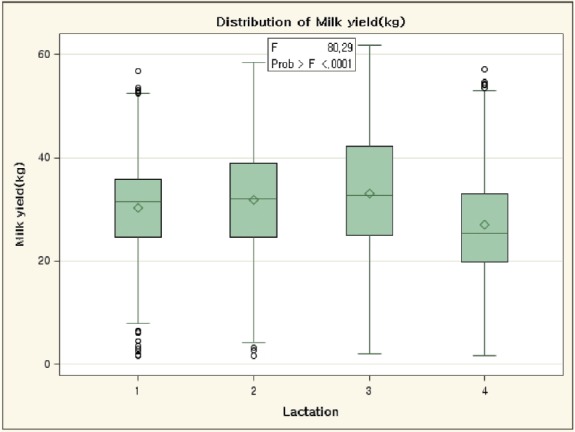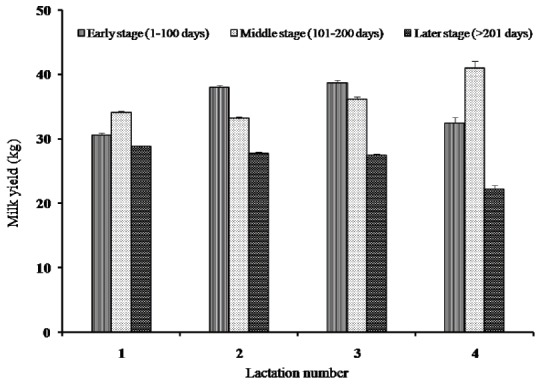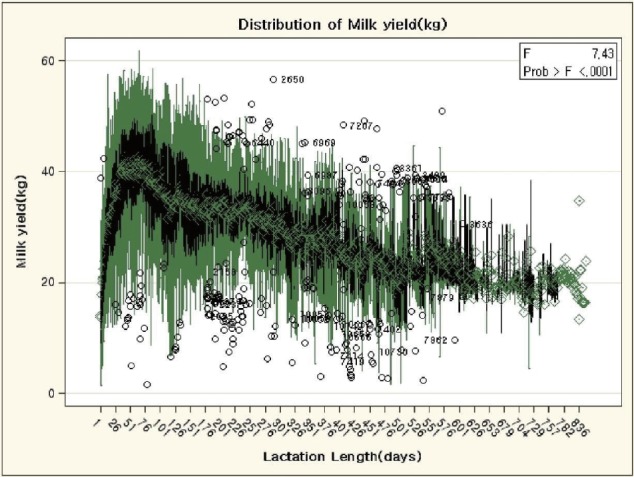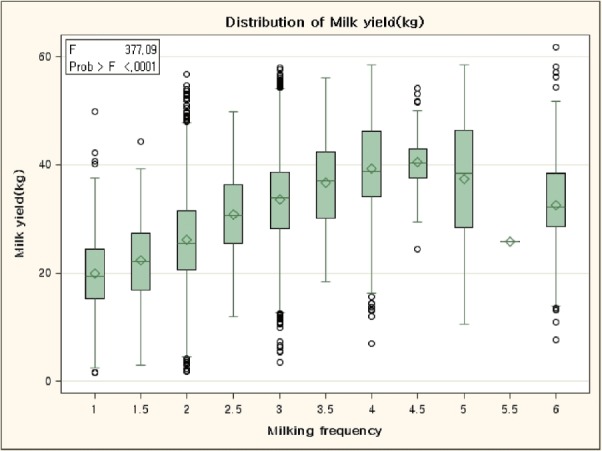Abstract
Objective
The aim of the current study was to describe the relationship between milk yield and lactation number, stage, length and milking frequency in Korean Holstein dairy cows using an automatic milking system (AMS).
Methods
The original data set consisted of observations from April to October 2016 of 780 Holstein cows, with a total of 10,751 milkings. Each time a cow was milked by an AMS during the 24 h, the AMS management system recorded identification numbers of the AMS unit, the cow being milking, date and time of the milking, and milk yield (kg) as measured by the milk meters installed on each AMS unit, date and time of the lactation, lactation stage, milking frequency (NoM). Lactation stage is defined as the number of days milking per cows per lactation. Milk yield was calculated per udder quarter in the AMS and was added to 1 record per cow and trait for each milking. Milking frequency was measured the number of milkings per cow per 24 hour.
Results
From the study results, a significant relationship was found between the milk yield and lactation number (p<0.001), with the maximum milk yield occurring in the third lactation cows. We recorded the highest milk yield, in a greater lactation length period of early stage (55 to 90 days) at a 4× milking frequency/d, and the lowest milk yield was observed in the later stage (>201 days) of cows. Also, milking frequency had a significant influence on milk yield (p<0.001) in Korean Holstein cows using AMS.
Conclusion
Detailed knowledge of these factors such as lactation number, stage, length, and milking frequency associated with increasing milk yield using AMS will help guide future recommendations to producers for maximizing milk yield in Korean Dairy industries.
Keywords: Milk Yield, Lactation Number, Lactation Length, Milking Frequency, Automatic Milking System (AMS), Korean Holstein Dairy Cows
INTRODUCTION
Automatic milking systems (AMS) are a revolutionary innovation in dairy farms, becoming popular in a variety of situations and environments all over the world [1] especially in the Republic of Korea. The essential factors of promoting use AMS for dairy cows are better organization of labour, increased milk yield and improved animal performance. AMS reduces the workload of milking and enables milking frequency to be controlled by an individual cow according to her milk production and lactation stage without incurring extra labour costs [2,3]. Also, AMS allows cows the freedom to go to milking at any time on a daily basis as well as dynamically changing intervals between milking throughout the lactation period. Some researchers have documented an increase in milk production of up to 12% for milking more than twice a day by AMS when compared with those milked twice a day in conventional systems. However, a few of researchers have reported no increase in milk production in dairy cows milked more than twice a day by AMS [4]. The milk yield and composition are affected by the systemic manipulation of milking frequency as well as lactation number in conventional systems. Smith et al [5], McNamara et al [6] reported that the milk yield was increased by up to 14% by increasing the fixed milking frequencies from 2 to 3×a day. For example, a comparison between fixed milking frequencies of 2 and 3 times a day showed a considerable increase of 3.5 kg/d of milk yield and 92 g/d of fat yield [7]. When the milking frequency was decreased to once in a day, the milk yield reduced by as much as 24% to 40% [6,8]. In most of the experiments the cows were housed indoors and fed a controlled diet. A few of the studies have attempted to determine the effects of increased milking frequency during the early lactation in grazing dairy cows. However, these study reports demonstrated the fixed milking frequency of 3 times a day for 3 weeks increased the average milk yield but with no long-term effect at all. The responsible mechanism underlying the increase milk production response to milking frequency and lactation number has not been developed, but some researchers have assumed may be due to an increased in mammary epithelial cells (MEC), reduction of MEC apoptosis, increase cell activity and frequent removal of the feedback inhibitor of lactation (FIL) from the mammary glands [6]. The lactation number also influences the milk yield in high-temperature conditions [9]. There was a considerable significant relationship observed between the first and second lactation and milk yield, whereas the maximum milk yield was obtained in the fourth lactation; it was not significantly different from the third lactation of dairy cows in conventional systems. The lactation stage also may have the significant effect on the milk yield. But, there is no well described scientific report on how changes in lactation stage, length and milking frequency between individual cows over a lactation affect milk yield using AMS has not been. Therefore, we aimed to provide data that would enable informed choices to maximize milk yield using AMS in an economically optimized way.
MATERIALS AND METHODS
Study herd and on-farm data collection
Data for the study was collected from 7 commercial dairy farms located in Kyunggi, Chongchung, and Kangwon province, Republic of Korea using Lely Astronaut (Maasssluis, The Netherlands) and VMS (voluntary milking system, DeLaval, Tumba, Sweden) AMS. The original data set consisted of observations from April to October 2016 of 780 Holstein cows, with a total of 10,751 milkings. The supplementation of concentrates (73% total digestible nutrients and 13% crude protein) at the rate of 6 kg/d for Holstein cows fed ad libitum. Thus, volume of supplementary feed could be adjusted to requirement depending on milk yield. The AMS management system recorded information each time a cow was milked by an AMS unit during the 24 h, and then the recorded database was downloaded twice per month for this study. This data included the automatic milking device and the cow being milk, date and time of the milking, and milk yield (kg) as measured by the milk meters installed on each AMS unit, date and time of the lactation, lactation stage (early, middle and later), milking frequency (NoM) (1.0, 1.5, 2.0, 2.5, 3.0, 3.5, 4.0, 4.5, 5.0, 5.5, and 6.0 at a day). Lactation stage is defined as the number of days milking per cow per lactation. Milk yield was calculated per udder quarter in the AMS and was added to 1 record per cow and trait for each milking. Milking frequency was the number of milkings per cow per 24 hour.
Statistical analysis
The JMP 9.2 (SAS Institute, Cary, NC, USA) program was used for statistical analyses. Results are expressed as the mean±standard of error of the mean. Comparisons between the means were evaluated using Student’s t-test. A probability of less than 0.001 was considered significances (p-value<0.001).
RESULTS
Effect of lactation number on milk yield
The trends for the total milk yields from each lactation number of the Holstein cows are shown in Figure 1. Results showed that the milk yield increased gradually from 1 to 3 lactation (30.30± 0.13, 31.83±0.15, 33.14±0.23 kg) cows (Table 1). The highest milk yield was noted in 3rd lactation cows (33.14±0.23 kg), and lowest milk yield was recorded in 4th lactation (27.02±0.49 kg) cows. Also, the current study results showed, where 300 days milk yield trends of cows with second lactation cows was 24.18% greater than that of first lactation cows (p<0.001), and third lactation cows produced 1.9% more milk than second lactation cows, fourth lactation cows showed decreased milk yield (16.04%) than third lactation cows.
Figure 1.

The effect of lactation number on milk yield in Korean Holstein dairy cows using automatic milking system.
Table 1.
The effect of lactation number on milk yield of Korean Holstein cows using automatic milking system
| Lactation | Sample size | Mean | Standard error | p-value | Milk yield minimum (kg) | Milk yield maximum (kg) |
|---|---|---|---|---|---|---|
| 1 | 3,895 | 30.30 | 0.13 | 0.001 | 1.50 | 56.70 |
| 2 | 4,105 | 31.83 | 0.15 | 0.001 | 1.60 | 58.49 |
| 3 | 2,263 | 33.14 | 0.23 | 0.001 | 2.00 | 61.80 |
| 4 | 488 | 27.02 | 0.49 | 0.001 | 1.60 | 57.04 |
Effect of lactation stage and length on milk yield
The average milk yields at different stages of lactation of Korean Holstein dairy cows are presented in Figure 2. Result of the current study showed that the average milk yields of first, second, third and fourth lactation of the Holstein dairy cows at early, middle and later stages were 30.52, 34.06, 28.76; 37.91, 33.13, 27.76; 38.61, 36.10, 27.40; and 32.42, 40.98, 22.16 kg/d respectively. The results revealed that 3rd lactation cows in the early stage had greater total milk yield. Also, we observed the highest peak of milk yield was obtained in an early stage, which stated that milk yield were gradually increased lactation length up to 90 days and remains high for a while and then declines in the later stage of lactation (Figure 3).
Figure 2.

Covariance between the lactation stages and lactation number on milk yield in Korean Holstein dairy cows using automatic milking system.
Figure 3.

The effect of lactation length on average milk yield in Korean Holstein dairy cows using automatic milking system.
Milking frequency on milk yield
Variations of milk productions according to milking frequency trends are given in Figure 4. Based on above result confirmation, we have found the 3rd lactation cow’s milk yield for 1.0×, 1.5×, 2.0×, 2.5×, 3.0×, 3.5×, 4.0×, 4.5×, 5.0×, 5.5×, 6.0× daily milking frequencies were 18.47±1.13, 21.39±1.78, 27.76±0.31, 32.40±0.89, 36.52±0.31, 45.37±1.43, 43.51±0.59, 45.70±1.77, 35.82±3.33, 24.89±0.12, and 35.68±1.45 kg respectively (Table 2). The statistical analysis of the study results showed that milking frequency had a considerable effect on milk yield (p<0.001). The milk yield for 1× milking a day was significantly lower (p<0.001) when compared with 2×, 3×, 4×, and more than 4× a daily milking frequency. From the current study, 4× a daily milking frequency cows showed the highest milk yield (p<0.001), after 4× a daily milking frequency cows showed declined milk yields.
Figure 4.

The effect of milking frequency on average milk yield in Korean Holstein dairy cows using automatic milking system.
Table 2.
The effect of milking frequency on milk yield of Korean Holstein cows using automatic milking system
| Milking frequency | Mean | Standard error | p-value | Milk yield minimum (kg) | Milk yield maximum (kg) |
|---|---|---|---|---|---|
| 1.0 | 19.94 | 0.57 | 0.001 | 1.50 | 49.78 |
| 1.5 | 22.36 | 0.65 | 0.001 | 2.90 | 44.30 |
| 2.0 | 26.14 | 0.13 | 0.001 | 1.80 | 56.70 |
| 2.5 | 30.78 | 0.45 | 0.001 | 11.90 | 49.90 |
| 3.0 | 33.62 | 0.12 | 0.001 | 3.50 | 58.00 |
| 3.5 | 36.77 | 0.50 | 0.001 | 18.30 | 56.00 |
| 4.0 | 39.31 | 0.25 | 0.001 | 6.90 | 58.49 |
| 4.5 | 40.57 | 0.70 | 0.001 | 24.40 | 54.10 |
| 5.0 | 37.47 | 1.22 | 0.001 | 10.50 | 58.50 |
| 5.5 | 25.80 | 0.21 | 0.001 | 25.80 | 25.80 |
| 6.0 | 35.52 | 0.80 | 0.001 | 7.60 | 61.80 |
DISCUSSION
Numerous studies have been demonstrated the effect of lactation number on milk yield of dairy cattle from gestation and parturition. Basically, all the studies have established that milk yield increases with increasing lactation number, and is maximized in fourth or fifth lactation in the conventional milking method [10–12]. Our current results exhibited the increased milk yield with increasing lactation number, which may be due to increasing development and size of the udder with a resulting increase of secretory cells [13]. Other reasons for high milk yield may be increased parity, which plays a significant role in the control of the tissue mobilization between the primiparous and multiparous cows [14], and includes increasing body weight of dairy cattle over that of first lactation. The present study results showed lower milk yield in 1st lactation cows, which may be due to early lactation of cows are not yet in the productive stage but remain in the growing stage with their mammary gland and mammary vein not well developed at this stage. Also, current study results exhibited greater milk yield in the 3rd lactation. But, cows with more than 3lactation, exhibited the tendency for total milk yield to decrease. This present study results agreed with Rey et al [10], who have reported in cows as lactation number from calving increased the total milk yield increased, but at a decreasing rate with lactation number. From the above findings, we concluded that cows with more than 3rd lactations are not good candidates for maximizing milk yield using AMS.
For more details of milk yield, data were statistically analysed on the basis of lactation stages (early, middle, and later). As mentioned first hundred days (1 to 100 days) were considered as early stage, second hundred days (101 to 200 days) were considered as middle stage, and the rest of the days (>201 days) were considered as later stage of lactation. The highest peak of milk yield was obtained in an early stage, which stated that milk yields were gradually increased up to 90 days and remained high for a while and then declined in the later stage of lactation (Figure 3). This may be due to the changes of hormones causing deterioration of the mammary gland, nutrient requirements of the fetus and insufficient nutrition for milk production. Our study results agreed with Hossain who has reported that cow’s milk yield decreases gradually as the lactation stages increase [15]. The current study agreed with Sekerden’s results, who reported that milk yield increasing gradually from the date of calving and highest yield was observed in the 2nd stage of lactation, thereafter milk yield decreased up to the end of lactation [16].
All 7 farms had significant differences in management, housing, milking interval, herd size, pen size. In spite of these variations, all farms exhibited similar response in increased milking frequency. The outline of variations in milk yield with increasing milking frequency observed in this study is steady with similar previous assessments [17] in conventional systems. The present study clearly showed the milk yield promoting effect of milking frequency in Korean Holstein dairy cows. This result agreed with several researchers who have published on effect of milking frequency on milk yield [18–23]. Numerous researchers have described the wide variation in milk yield during 1× daily milking frequency. This may be controlled by the balance between proliferation of mammary gland cells and apoptosis, breed, lactation number, lactation stage, nutrient levels and increase in the concentration of mammary gland secreted putative FIL [24], and intra mammary pressure [25]. In addition, loss of tight junction also plays an important role in milk production in once daily milking [26]. It should also be noted that when less frequent milking is prolonged, the decrease in milk production is sustained by chronological developmental adaptation, initially as a down regulation of cellular differentiation [27], and later as a total loss of mammary cell number through apoptosis [28]. The significant difference observed with increasing milking frequency with increase the milk productions in this study results. This study results also concurred with Stelwagen [21], who reported that increasing milking frequency from 2× to 3× in cows resulted in 18% increase, Erdman and Varner [7]; Jurjanz et al [29] and Van der Iest and Hilerton [30] also reported that increasing milking frequency from 2× to 3× in cows resulted 10% to 20% increase milk productions.
The current study, demonstrated a wide range of relationships between milk yield across farms utilizing AMS, has benefitted from a large sample farms in diverse locations applying very different strategies such as lactation number, stage, length and milking frequency. From our current study findings, 3rd lactation cows had a greater milk yield during early stage at a 4× milking frequencies/day, and provides evidence for a strong individual distinction in lactation number, lactation stage, milking frequency that correlates to individual features in milk yield of AMS in Korean Holstein dairy cows. The results are associated with relatively healthy animals and should contribute to the benchmarking process in the dairy industry. Hence, this result can be used to advise benchmarks regarding obtaining high milk yields from Korean Holstein dairy cows using AMS. Further studies should be carried out to elucidate the molecular mechanisms of each above factors contribution to the maximize milk productions in Korean Holstein dairy cows.
ACKNOWLEDGMENTS
The authors are grateful to the Cooperative Research Program for Agricultural Science and Technology Development (Project title: Studies on the growth curve of dairy cows during lactation; Project No: PJ012015012016, Rural Development Administration, Republic of Korea). This study was supported by Postdoctoral Fellowship Program of National Institute of Animal Science, Rural Development Administration, Republic of Korea.
Footnotes
CONFLICT OF INTEREST
We certify that there is no conflict of interest with any financial organization regarding the material discussed in the manuscript.
REFERENCES
- 1.De Koning CJAM. Automatic milking-A common practice on dairy farms. Proceedings of the First North American Conference on Precision Dairy Management; Mar 2–Mar 6; Toronto, Canada: Ontario Agriculture; 2010. pp. 52–67. [Google Scholar]
- 2.Jacobs JA, Siegford JM. Invited review: The impact of automatic milking systems on dairy cow management, behavior, health, and welfare. J Dairy Sci. 2012;95:2227–47. doi: 10.3168/jds.2011-4943. [DOI] [PubMed] [Google Scholar]
- 3.Svennersten-Sjaunja KM, Pettersson G. Pros and cons of automatic milking in Europe. J Anim Sci. 2008;86:37–46. doi: 10.2527/jas.2007-0527. [DOI] [PubMed] [Google Scholar]
- 4.Speroni M, Pirlo G, Lolli S. Effect of automatic milking systems on milk yield in a hot environment. J Dairy Sci. 2006;89:4687–93. doi: 10.3168/jds.S0022-0302(06)72519-X. [DOI] [PubMed] [Google Scholar]
- 5.Smith JW, Ely LO, Graves WM, Gilson WD. Effect of milking frequency on DHI performance measures. J Dairy Sci. 2002;85:3526–33. doi: 10.3168/jds.S0022-0302(02)74442-1. [DOI] [PubMed] [Google Scholar]
- 6.McNamara S, Murphy JJ, O’Mara FP, Rath M, Mee JF. Effect of milking frequency in early lactation on energy metabolism, milk production and reproductive performance of dairy cows. Livest Sci. 2008;117:70–8. [Google Scholar]
- 7.Erdman RA, Varner M. Fixed yield responses to increased milking frequency. J Dairy Sci. 1995;78:1199–203. doi: 10.3168/jds.S0022-0302(95)76738-8. [DOI] [PubMed] [Google Scholar]
- 8.Remond R, Pomies D, Julien C, Guinard-Flament J. Performance of dairy cows milked twice daily at contrasting intervals. Animal. 2009;3:1463–71. doi: 10.1017/S1751731109990371. [DOI] [PubMed] [Google Scholar]
- 9.Amani Z, Gader A, Khair M, Lutfi A, Peters K. Milk yield and reproductive performance of Friesian cows under Sudan tropical conditions. Arch Tierz. 2007;50:155–64. [Google Scholar]
- 10.Ray DE, Halbach TJ, Armstrong DV. Season and lactation number effects on milk production and reproduction of dairy cattle in Arizona. J Dairy Sci. 1992;75:2976–83. doi: 10.3168/jds.S0022-0302(92)78061-8. [DOI] [PubMed] [Google Scholar]
- 11.Arbel R, Bigun Y, Ezra E, Sturman H, Hojman D. The effect of extended calving intervals in high lactating cows on milk production and profitability. J Dairy Sci. 2001;84:600–8. doi: 10.3168/jds.s0022-0302(01)74513-4. [DOI] [PubMed] [Google Scholar]
- 12.Cilek S. Milk yield traits of Holstein cows raised at Polatli state farm in Turkey. J Anim Vet Adv. 2009;8:6–10. [Google Scholar]
- 13.Sorensen MT, Norgaard JV, Theil PK, Vestergaard M, Sejrsen K. Cell turnover and activity in mammary tissue during lactation and the dry period in dairy cows. J Dairy Sci. 2006;89:4632–9. doi: 10.3168/jds.S0022-0302(06)72513-9. [DOI] [PubMed] [Google Scholar]
- 14.Wathes DC, Cheng Z, Bourne N, et al. Differences between primiparous and multiparous dairy cows in the inter-relationships between metabolic traits, milk yield and body condition score in the periparturient period. Domest Anim Endocrinol. 2007;3:203–25. doi: 10.1016/j.domaniend.2006.05.004. [DOI] [PubMed] [Google Scholar]
- 15.Hossain AM. A study of average percentage of fat, total solids, solids-not-fat content of local cow’s milk and the variation of milk fat percentage with the stage of lactation [Master’s thesis] Mymensingh, East Pakistan: Agricultural University; 1968. [Google Scholar]
- 16.Sekerden O. Relationships between lactation stage with milk yield and constituents, and heritabilities of milk constituents. Hay Uret J Anim Prod. 2002;43:61–7. [Google Scholar]
- 17.Alshaikh MA, Salah MS. Effect of milking interval on secretion rate and composition of camel milk in late lactation. J Dairy Res. 1994;61:451–6. doi: 10.1017/s0022029900028375. [DOI] [PubMed] [Google Scholar]
- 18.Pearson RE, Fulton LA, Thompson PD, Smith JW. Three times a day milking during the first half of lactation. J Dairy Sci. 1979;62:1941–50. doi: 10.3168/jds.S0022-0302(79)83526-2. [DOI] [PubMed] [Google Scholar]
- 19.Poole DA. The effects of milking cows three times daily. Anim Prod. 1982;34:197–201. [Google Scholar]
- 20.Archer P. Milk Marketing Board Report. Vol. 34. Farm Management Service (FMI); Great Britain: 1983. Milking three times a day; p. 33. [Google Scholar]
- 21.Archer P. Milking three times a day: Farm management service (FMI) Great Britain: Milk Marketing Board; 1983. 1983. [Google Scholar]
- 22.Stelwagen K. Effect of milking frequency on mammary functioning and shape of the lactation curve. J Dairy Sci. 2001;84:E204–E11. [Google Scholar]
- 23.Salama AAK, Such X, Caja G, et al. Effects of once versus 2× daily milking throughout lactation on milk yield and milk composition in dairy goats. J Dairy Sci. 2003;86:1673–80. doi: 10.3168/jds.S0022-0302(03)73753-9. [DOI] [PubMed] [Google Scholar]
- 24.VanBaale MJ, Ledwith DR, Thomson JM, et al. Effect of increased milking frequency in early lactation with or without recombinant bovine somatotropin. J Dairy Sci. 2005;88:3905–12. doi: 10.3168/jds.S0022-0302(05)73076-9. [DOI] [PubMed] [Google Scholar]
- 25.Wilde CJ, Addey CVP, Boddy LM, Peaker M. Autocrine regulation of milk secretion by protein in milk. Biochem J. 1995;305:51–8. doi: 10.1042/bj3050051. [DOI] [PMC free article] [PubMed] [Google Scholar]
- 26.Peaker M. The effect of raised intramammary pressure on mammary function in the goat in relation to the cessation of lactation. J Physiol. 1990;301:415–28. doi: 10.1113/jphysiol.1980.sp013214. [DOI] [PMC free article] [PubMed] [Google Scholar]
- 27.Stelwagen K, Davis SR, Farr VC, Prosser CG, Sherlock RA. Mammary epithelial cell tight junction integrity and mammary blood flow during an extended milking interval in goats. J Dairy Sci. 1994;77:426–32. doi: 10.3168/jds.S0022-0302(94)76969-1. [DOI] [PubMed] [Google Scholar]
- 28.Wilde CJ, Henderson AJ, Knight CH, et al. Effects of long-term 3× daily milking on mammary enzyme activity, cell population and milk yield in the goat. J AnimSci. 1987;64:533–9. doi: 10.2527/jas1987.642533x. [DOI] [PubMed] [Google Scholar]
- 29.Jurjanz S, Laurent F, Graupner M. Effect of increased milk frequency on milk composition. Mh Vet Med. 1993;48:631–4. [Google Scholar]
- 30.Van der Iest R, Hilerton JE. Short-term effects of frequent milking of dairy cows. J Dairy Res. 1989;56:587–92. doi: 10.1017/s0022029900029101. [DOI] [PubMed] [Google Scholar]


